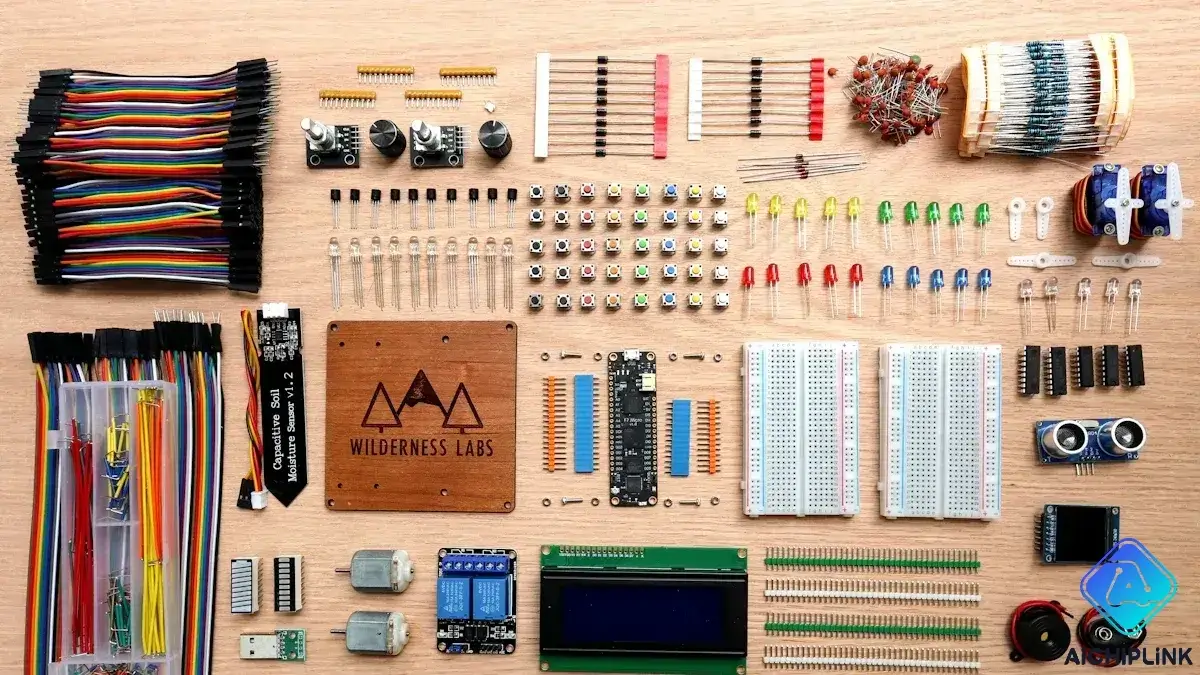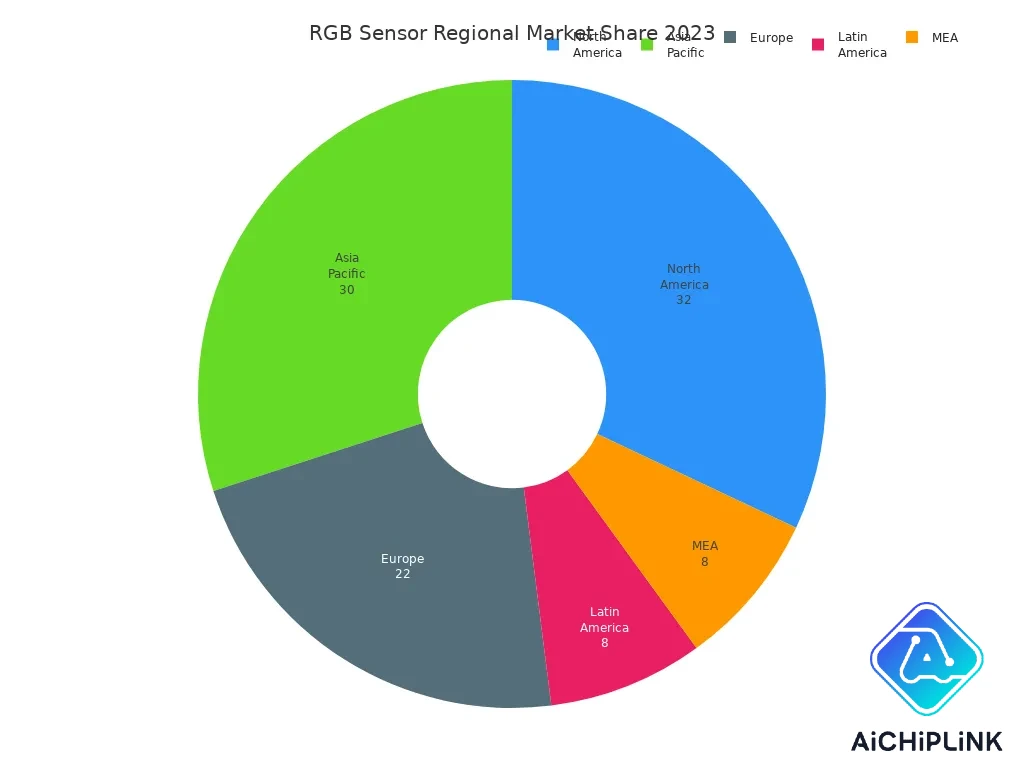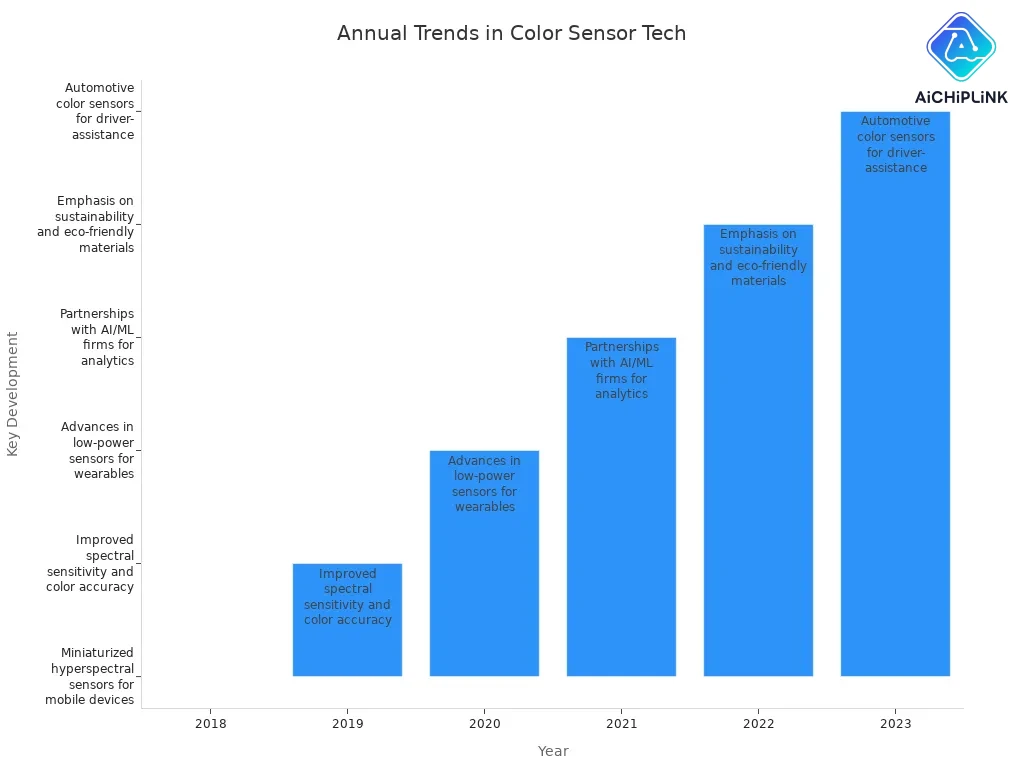
The ADJD-E622-QR999 is a small, powerful rgb color sensor. It is made to detect colors very accurately. This sensor has a photodiode array, trans-impedance amplifiers, and a white LED inside. These parts help it measure colors in a steady and correct way. In electronics and manufacturing, e622 sensors transducers like this one are very important. They use little power but still work very well. More people around the world want rgb color sensor technology. The market for these sensors is growing fast:

| Specification | ADJD-E622-QR999 | ADJD-S313-QR999 |
|---|---|---|
| Supply Voltage | 4.5 V to 5.5 V | 2.5 V to 3.6 V |
| Current Consumption | ~2.4 mA @ 5 V | Up to 9.4 mA @ 2.6 V |
| Built-in Illumination | White LED | Not specified |
These features make the ADJD-E622-QR999 very useful. It is needed when e622 sensors transducers must sense colors well and work efficiently.
Key Takeaways
-
The ADJD-E622-QR999 is a small and accurate color sensor. It can find red, green, and blue light very well.
-
It does not use much power and works in many temperatures. This makes it good for battery devices and machines in factories.
-
There is a white LED inside that gives steady light. This helps the sensor see colors clearly, even when it is dark or the light changes.
-
Many factories and companies use this sensor. It helps check colors and makes products better.
-
The sensor is small, works well, and is smart. It is ready for new things like smart homes and connected devices.
e622 Sensors Transducers Overview
What is the ADJD-E622-QR999
The ADJD-E622-QR999 is a rgb color sensor. It belongs to the e622 sensors transducers family. This sensor can find out how much red, green, and blue light is around it. All its parts are built into one chip. This makes the sensor small and helps it work well. The sensor is tiny, only 5 x 5 x 0.75 mm. It can fit inside many different devices.
Inside, there is a photodiode array. Each array has three groups of 3x3 photodiodes. These photodiodes have special filters for red, green, and blue. The filters help the sensor tell the colors apart. The sensor also has amplifiers inside. These amplifiers make the signals from the photodiodes stronger. This helps the sensor read the signals better.
Here is a table that lists the main parts and features of the ADJD-E622-QR999:
| Component / Feature | Description |
|---|---|
| Sensor Type | Monolithic CMOS IC |
| Photodiode Array | 3 sets of 3x3 photodiode arrays |
| Color Filters | Red, Green, Blue (R, G, B) color filters coating photodiodes |
| Amplification | Integrated transimpedance amplifiers |
| Gain Control | Independent gain selection for each R, G, B channel |
| Design Purpose | Minimizes contamination and optical aperture misalignment effects |
| Qualification | Automotive AEC-Q100 Standard (Grade 3) |
| Package Size and Type | Robust, compact package measuring 5 x 5 x 0.75 mm |
The sensor meets a special car standard called AEC-Q100 (Grade 3). This means it works well in cars and trucks. Many engineers use e622 sensors transducers like this in car lights and LED lights. The sensor is also used in other electronics that need to see colors correctly.
How It Works
The ADJD-E622-QR999 changes light into voltage. When light hits the sensor, the photodiode array takes it in. Each photodiode only reacts to one color because of its filter. The sensor splits the light into red, green, and blue signals. The amplifiers make these signals stronger. This helps the sensor notice even small color changes.
You can change how sensitive the sensor is to each color. This means you can make it more or less sensitive to red, green, or blue. This helps the sensor work in different kinds of light. The sensor also has a white LED inside. The LED shines on things so the sensor can see colors better.
Many devices use spi communication to talk to the sensor. This lets the sensor send color data fast to a computer or microcontroller. Some systems use spi communication to control the sensor and get its data. The sensor is small and does not use much power. This makes it good for portable devices.
Note: The ADJD-E622-QR999 is special because it is accurate, small, and easy to use. Its design helps stop mistakes from dust or things not lining up right. That is why many people trust it for measuring color in lots of areas.
Key Features
The ADJD-E622-QR999 is special because of its main features. These features help it find colors correctly and work in many devices. The sensor is very sensitive and accurate. It does not use much power. It works in hot or cold places. It also has a steady light built in. These things make it a favorite for engineers and designers.
High Accuracy
The ADJD-E622-QR999 can find colors very well. It uses smart light-to-frequency technology. This helps it measure red, green, and blue colors exactly. The sensor can see even tiny color changes. This is important for jobs that need perfect color matching. For example, it helps in factories or sorting machines.
The sensor lets you change how much it reacts to each color. You can make it more or less sensitive to red, green, or blue. This helps it stay accurate in different lights. Its design also stops mistakes from dust or things not lined up right. This makes the sensor give good results every time.
Low Power Consumption
The sensor does not use much power. It only needs about 2.4 mA at 5 V. This is good for things that run on batteries. Devices with this sensor can last longer before charging or changing batteries.
The sensor works in many temperatures, from 0°C to 70°C. It can work in hot or cold places without using extra energy. Using less power means less heat and saves energy. This is good for the planet and for how the device works.
Built-in White LED
The sensor has a white LED inside. This LED gives a steady light for the sensor. The light shines evenly on what the sensor looks at. This helps the sensor see colors clearly, even when it is dark or the light changes.
-
The white LED gives steady and even light.
-
This helps stop problems from outside light.
-
Even light helps the sensor see small color changes.
-
The LED is helpful in dark or changing light.
-
The white LED helps the sensor find colors correctly by blocking outside light.
The white LED makes the sensor work better. It helps the sensor find colors right in many places. This is great for devices that work in different lights.
Tip: The ADJD-E622-QR999 is easy to use in many electronics. Its small size and wide voltage range help engineers put it in many products. The sensor works well in both factory and home devices.
High accuracy, low power use, and steady light make the ADJD-E622-QR999 a strong pick for finding colors. These features help it give exact results and make it easy to use in many ways.
Color Sensing Applications
Manufacturing Uses
Factories use the ADJD-E622-QR999 sensor for many jobs. These jobs need to find colors exactly. The sensor helps machines check product colors on the line. Workers do not have to use their eyes, which can be wrong. The sensor can see small color changes. This helps sort items and check labels. It also makes sure products match color codes. The white LED inside gives steady light. This means the sensor works even if room lights change. The sensor is small, so it fits in machines easily. It gives fast feedback. This lets the system fix problems right away. It helps save money and cut down on waste.
Quality Control
Quality control teams use color detection to check products. The ADJD-E622-QR999 sensor checks if colors match on parts and packages. It can find tiny color changes that people may not see. The sensor helps companies keep products looking good. It also helps meet company standards. The sensor finds mistakes early. This stops factories from making lots of wrong products. The sensor works fast. Teams can fix errors before they cost too much. Using this sensor helps companies make better products. It also lowers the number of bad items.
Accurate color detection is very important for quality control. It helps companies keep customers happy and protect their brand.
Consumer Electronics
Many electronics need to sense color well. Devices like monitors, printers, and VR headsets use sensors. These sensors help check and fix color. The ADJD-E622-QR999 sensor helps these devices show bright, true colors. It measures color as you use the device. This keeps screens and lights looking the same each time. In 3D printing, the sensor checks the color of each object. This makes sure things look right and work well.
Color matters in all parts of life today. Good color detection helps factories, quality teams, and electronics makers. It helps them make products that look great and work well.
Benefits and Challenges
Industry Advantages
The ADJD-E622-QR999 color sensor gives many good things to industries today. It is known for being very accurate, using little power, and being reliable. The table below shows how this sensor is better than others in important ways:
| Feature | Advantage |
|---|---|
| Highly accurate RGB color detection | Finds small color differences, improving quality control |
| Stable built-in white LED illumination | Reduces outside light problems, keeps results steady |
| Compact 5x5x0.75 mm QFN-16 package | Fits easily into machines and devices |
| Monolithic CMOS IC with photodiode array and RGB filters | Gives precise and reliable color sensing |
| Independent gain selection for each RGB channel | Lets users adjust for different lights and uses |
| 3x3 photodiode array design | Lowers risk from dust and misalignment |
| Automotive AEC-Q100 Standard Grade 3 qualification | Works well in tough industrial settings |
| Wide operating temperature and voltage range | Handles many work conditions |
| Real-time feedback capability | Helps fix problems fast and lowers mistakes |
These features help factories and tech companies make better products. The sensor lets machines sort things fast and check colors quickly. It also helps make changes right away. This means there is less waste and better quality.
Implementation Considerations
Engineers have some problems when using this sensor. Dust, changes in temperature, and different lights can change its readings. Calibrating the sensor often helps keep it correct. Using covers or putting the sensor in a smart spot can stop dust from getting in. Setting the right gain for each color is important for good results. Teams should test the sensor in real places before using it everywhere. Teaching workers how to set up and care for the sensor helps stop mistakes.
Note: Setting up the sensor well and checking it often helps it last longer and work better.
Future Trends
Color sensor technology is getting better every year. New sensors are smaller, smarter, and connect more easily. Some new sensors use AI to see color changes and fix settings by themselves. This makes them more exact and simple to use. Companies now put color sensors together with image processing and wireless links. These changes help sensors work in more places, like smart homes, cars, and medical tools.

The ADJD-E622-QR999 already fits many new needs. Its small size, strong build, and flexible design make it ready for the future. As more devices get smarter and connect together, this sensor will become even more important.
The ADJD-E622-QR999 is better than many e622 sensors transducers. It can find colors very well and does not use much power. The sensor has a white LED inside and is very small. This helps it fit in lots of devices. Engineers like this sensor because it works well in factories and electronics. If you need a good color sensor, you should think about the ADJD-E622-QR999 for new projects.
FAQ
What devices use the ADJD-E622-QR999 color sensor?
Many devices use this sensor. Engineers put it in printers, monitors, sorting machines, and smart lighting systems. It helps these devices see and measure colors correctly.
How does the built-in white LED help the sensor?
The white LED gives steady light. This helps the sensor see colors clearly, even when room lights change. The LED makes color readings more accurate.
Can the ADJD-E622-QR999 work in hot or cold places?
Yes. The sensor works well from 0°C to 70°C. It keeps giving correct color readings in both hot and cold environments.
Is the ADJD-E622-QR999 easy to add to new products?
Yes. The sensor is small and uses little power. Engineers can fit it into many products. It also works with common communication systems like SPI.
What makes the ADJD-E622-QR999 better than other color sensors?
This sensor gives very accurate color readings. It uses little power and has a built-in white LED. Its design helps it work well in many different devices and places.

Written by Jack Elliott from AIChipLink.
AIChipLink, one of the fastest-growing global independent electronic components distributors in the world, offers millions of products from thousands of manufacturers, and many of our in-stock parts is available to ship same day.
We mainly source and distribute integrated circuit (IC) products of brands such as Broadcom, Microchip, Texas Instruments, Infineon, NXP, Analog Devices, Qualcomm, Intel, etc., which are widely used in communication & network, telecom, industrial control, new energy and automotive electronics.
Empowered by AI, Linked to the Future. Get started on AIChipLink.com and submit your RFQ online today!




